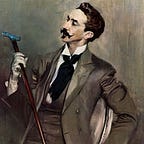The Breezy Brutality of Marguerite Duras’ The Lover
Published almost 40 years ago, Duras’ novel might strike the modern reader as too blunt, even if it simultaneously also resembles the dreamiest poetry.
Something many French-speaking literary giants have in common is the attraction towards confessional autobiographical writing. Ever since Jean-Jacques Rousseau released his Confessions in the 18th century, many notable authors have followed suit by revealing to their audience how they came of age and became the celebrities they are now. However, in spite of the popularity of the genre, autobiographical texts in French are often easily forgotten because of the sheer number of them released every year. In order for them to stand the test of time, the author must offer a perspective that is unique. In the 20th century notable examples include Jean Genet’s documentation of the Parisian lumpenproletariat in The Thief’s Journal, Annie Ernaux’s dry but compelling sketches of her working-class youth in her many books, and Hervé Guibert’s diaries about life as a gay man in Europe during the peak of the AIDS crisis. Another example that has deservedly attracted lots of attention from general and academic readers is Marguerite Duras’ 1984 autobiographical novel The Lover (French: L’amant). Duras’ account of her youth in French Indochina, including life with a highly dysfunctional family and an affair with the son of a prominent Chinese-Vietnamese businessman is definitely an oddity. Furthermore, even though the events she describes revolve around highly sensitive topics (such as emotional and physical abuse, racism in the French colonies, and issues of consent in relationships involving teenagers and adults), Duras is not afraid to be honest with the reader. There is no romanticizing of her colonial childhood nor of the trauma that she carried until her death. In spite of this, however, the book manages to also flirt with the genre of poetry. Descriptions of her lover and of the Indochinese landscapes and people she sees abound and transport the reader to a world that no longer exists but that has been saved in these pages for eternity.
The Lover refuses to acknowledge traditional chronology and instead goes back and forth between Duras’ present as a famous French writer and her childhood and youth in French Indochina, with a short stop in occupation era-Paris. Although the title hints at the centrality of her love affair, of equal importance to the book is her family life. The sudden death of her father impacted her family not only emotionally but financially, as they had to survive without him in Indochina. She recalls feeling quite ambivalent towards her mother, whom she often sympathized with and liked catching glimpses of joy from but who also displayed favoritism towards her rowdy older brother and who envisioned a traditional married life for her. She also narrates the Cain and Abel-esque story of her brothers — one died during his youth, leaving her with a sorrow that she remembers too clearly, while the other lived in selfishness and vagrancy for decades until becoming a middle-aged man who could barely provide for himself. Duras doesn’t preface her family life by insisting that she loves them or misses them — quite the contrary, she lets the reader know that at this point of life they don’t mean much to her anymore. Nonetheless, the text proves otherwise. Duras’ scattered memories of her broken family written when she was in her seventies prove that family leaves permanent marks on an individual.
Duras’ book becomes more memorable, however, due to her description of her unusual love affair. She prefaces descriptions of it by insisting that racial relations in colonial Indochina would never have allowed her and her lover to have a normal relationship; an Asian man marrying a white woman was scandalous, even if not uncommon judging by the existence of many mixed children. In addition to the racial barrier, there was a generational one, as Duras dated this man when she was only a teenager. He was her first lover, and though she was never quite sure how she felt about her, he still occupied a place in her heart well into the time she wrote the novel. She admits that he wasn’t particularly handsome or charming, but that he was caring, passionate and somber in an endearing way. The multiple scenes that describe their relationship emphasize that both of them knew their affair was not socially viable and therefore could exist outside the norms that made those relationships boring. Eventually, she had to leave to France and forget all about her lover. She eventually heard of him again decades later when he was visiting France and called her to tell her he was aware of her literary reputation. Even though Duras makes it clear that a life with him was always out of the question, there is an unconfessed sense of loss permeating the last pages about her affair.
Duras is very likely the only French woman to have written about a love affair during her rebellious teen years in French Indochina, but this isn’t the only reason why The Lover is worth reading. She writes about it in a manner that makes the reader want to read all night; you have traumatic scenes juxtaposed with dreamy descriptions of the Mekong River and the streets of Saigon. The Lover is somehow both a historical document detailing the colonialism of Indochina and a series of poetic prose about life, its good and terrible sides.
